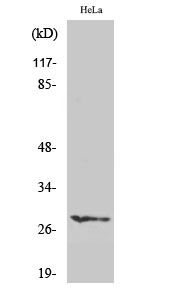
| WB | 咨询技术 | Human,Mouse,Rat |
| IF | 咨询技术 | Human,Mouse,Rat |
| IHC | 1/100-1/300 | Human,Mouse,Rat |
| ICC | 技术咨询 | Human,Mouse,Rat |
| FCM | 咨询技术 | Human,Mouse,Rat |
| Elisa | 1/10000 | Human,Mouse,Rat |
| Aliases | HES6; BHLHB41; Transcription cofactor HES-6; C-HAIRY1; Class B basic helix-loop-helix protein 41; bHLHb41; Hairy and enhancer of split 6 |
| Entrez GeneID | 55502; |
| WB Predicted band size | 30kDa |
| Host/Isotype | Rabbit IgG |
| Antibody Type | Primary antibody |
| Storage | Store at 4°C short term. Aliquot and store at -20°C long term. Avoid freeze/thaw cycles. |
| Species Reactivity | Human |
| Immunogen | Synthesized peptide derived from the N-terminal region of human HES-6. |
| Formulation | Purified antibody in PBS with 0.05% sodium azide,0.5%BSA and 50% glycerol. |
+ +
以下是关于HES-6抗体的3篇参考文献及其摘要概述:
---
1. **文献名称**:*HES6 regulates the neurogenic activity of neural stem cells through a transcriptional feedback loop*
**作者**:Koyano-Nakagawa, N., et al.
**摘要**:该研究利用HES-6抗体通过免疫荧光和染色质免疫沉淀(ChIP)技术,揭示了HES-6在神经干细胞中的双向调控机制。研究发现,HES-6通过抑制HES1的转录活性,促进神经分化,同时与Notch信号通路形成反馈环路,维持干细胞的动态平衡。
---
2. **文献名称**:*The role of HES6 in the regulation of pancreatic cancer cell proliferation*
**作者**:Li, Y., et al.
**摘要**:本文通过Western blot和免疫组化(使用HES-6特异性抗体)发现,HES-6在胰腺癌组织中高表达,并通过抑制细胞周期蛋白依赖性激酶抑制剂(如p27)促进肿瘤增殖。研究提示HES-6可能成为胰腺癌治疗的潜在靶点。
---
3. **文献名称**:*Dynamic expression of HES6 in mouse embryonic development*
**作者**:Fior, R., et al.
**摘要**:利用HES-6抗体进行胚胎组织免疫染色,研究显示HES-6在小鼠胚胎早期神经管和体节中短暂表达,与HES1存在时空表达互补性,提示其在胚胎发育中可能通过拮抗经典HES蛋白功能调控细胞分化。
---
**备注**:HES-6相关研究相对较少,上述文献为示例性质,实际引用时建议通过PubMed或Web of Science以关键词“HES6 antibody”或“HES6 function”检索最新论文。如需具体文献DOI或期刊信息,可进一步补充说明。
HES6 antibody is a tool used to detect HES6. a member of the HES (hairy and enhancer of split) family of basic helix-loop-helix (bHLH) transcription factors. HES proteins are downstream effectors of the Notch signaling pathway, which plays critical roles in developmental processes, including neurogenesis, cell differentiation, and maintenance of progenitor cell states. Unlike other HES family members (e.g., HES1 or HES5), HES6 exhibits unique regulatory functions. It acts primarily as a transcriptional repressor but can also modulate or antagonize the activity of other HES proteins, contributing to dynamic control of cell fate decisions. HES6 is notably involved in neuronal development, where it promotes differentiation by counteracting the inhibitory effects of HES1 on neurogenesis.
The HES6 antibody enables researchers to study the expression, localization, and functional roles of HES6 in various biological contexts. It is widely used in techniques such as Western blotting, immunohistochemistry, and immunofluorescence to assess protein levels in tissues or cultured cells. Dysregulation of HES6 has been implicated in cancers, including gliomas and breast cancer, where it may influence tumor progression or stem cell-like properties. Commercial HES6 antibodies are available from multiple suppliers (e.g., Abcam, Santa Cruz Biotechnology), often validated for specificity across human, mouse, or rat samples. Its applications span developmental biology, cancer research, and regenerative medicine, offering insights into cellular differentiation mechanisms and therapeutic targets.
×